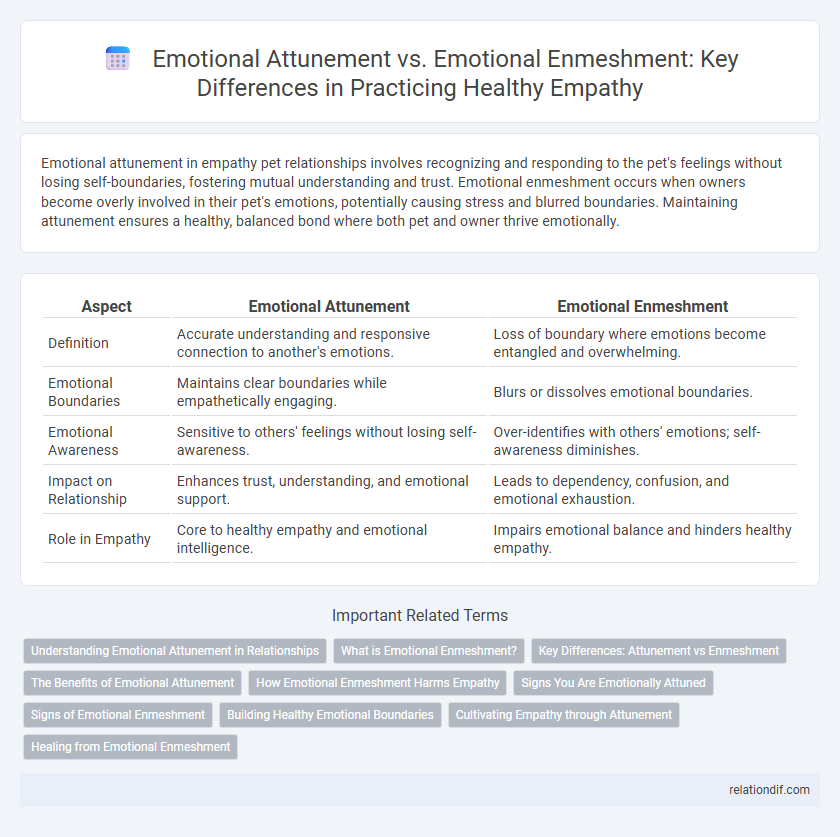Emotional attunement in empathy pet relationships involves recognizing and responding to the pet's feelings without losing self-boundaries, fostering mutual understanding and trust. Emotional enmeshment occurs when owners become overly involved in their pet's emotions, potentially causing stress and blurred boundaries. Maintaining attunement ensures a healthy, balanced bond where both pet and owner thrive emotionally.
Table of Comparison
| Aspect | Emotional Attunement | Emotional Enmeshment |
|---|---|---|
| Definition | Accurate understanding and responsive connection to another's emotions. | Loss of boundary where emotions become entangled and overwhelming. |
| Emotional Boundaries | Maintains clear boundaries while empathetically engaging. | Blurs or dissolves emotional boundaries. |
| Emotional Awareness | Sensitive to others' feelings without losing self-awareness. | Over-identifies with others' emotions; self-awareness diminishes. |
| Impact on Relationship | Enhances trust, understanding, and emotional support. | Leads to dependency, confusion, and emotional exhaustion. |
| Role in Empathy | Core to healthy empathy and emotional intelligence. | Impairs emotional balance and hinders healthy empathy. |
Understanding Emotional Attunement in Relationships
Emotional attunement in relationships involves accurately perceiving and responding to a partner's feelings, fostering mutual understanding and trust. This process enhances emotional connection without losing personal boundaries, ensuring healthy communication and support. In contrast, emotional enmeshment blurs these boundaries, leading to codependency and potential emotional overwhelm.
What is Emotional Enmeshment?
Emotional enmeshment occurs when personal boundaries between individuals become blurred, leading to excessive emotional dependence and loss of individual identity. This dynamic often results in unhealthy relationships where emotions are entangled, making it difficult for individuals to distinguish their own feelings from those of others. Recognizing emotional enmeshment is crucial for establishing healthy interpersonal connections and maintaining emotional autonomy.
Key Differences: Attunement vs Enmeshment
Emotional attunement involves recognizing and responding to another person's feelings with appropriate empathy, maintaining healthy boundaries and supporting emotional growth. Emotional enmeshment blurs personal boundaries, leading to excessive emotional involvement and loss of individuality between individuals. Key differences include the ability to balance connection with autonomy in attunement, versus the overdependence and lack of emotional differentiation characterizing enmeshment.
The Benefits of Emotional Attunement
Emotional attunement fosters deeper understanding and connection by accurately perceiving and responding to another's feelings, enhancing interpersonal trust and communication. It supports emotional regulation and resilience by creating a safe space for vulnerability and authentic expression. Unlike emotional enmeshment, attunement maintains healthy boundaries, promoting individual autonomy while strengthening relational empathy.
How Emotional Enmeshment Harms Empathy
Emotional enmeshment blurs personal boundaries, causing individuals to lose their sense of self and impairing genuine empathetic responses. Unlike emotional attunement, which fosters understanding and healthy connection, enmeshment leads to codependency and emotional overwhelm, reducing the ability to accurately perceive and respond to others' feelings. This distortion of empathy can result in emotional exhaustion and hinder effective communication within relationships.
Signs You Are Emotionally Attuned
Recognizing signs of emotional attunement includes being fully present during conversations, accurately perceiving others' feelings, and responding with supportive empathy without losing your own emotional boundaries. You maintain a clear sense of self while deeply understanding and validating another person's emotional experience. This balance contrasts with emotional enmeshment, where boundaries blur and personal emotions become entangled, undermining healthy relationships.
Signs of Emotional Enmeshment
Signs of emotional enmeshment include a blurred sense of boundaries where individuals struggle to distinguish their feelings from others, leading to excessive dependence and loss of personal autonomy. People exhibiting emotional enmeshment often experience heightened anxiety when separated from the other person, coupled with a compulsion to control or be controlled in emotional exchanges. This dynamic disrupts healthy emotional regulation and impairs the development of independent self-identity.
Building Healthy Emotional Boundaries
Emotional attunement involves recognizing and responding to another person's feelings with sensitivity while maintaining a clear sense of self, which supports building healthy emotional boundaries. Emotional enmeshment occurs when personal boundaries blur, leading to over-involvement and loss of individual emotional autonomy. Establishing emotional boundaries preserves mental well-being and fosters empathetic relationships without compromising personal identity.
Cultivating Empathy through Attunement
Emotional attunement involves sensitively perceiving and responding to others' feelings without losing personal boundaries, fostering genuine empathy through active listening and validation. In contrast, emotional enmeshment blurs these boundaries, leading to over-identification and emotional overwhelm. Cultivating empathy through attunement enhances emotional intelligence and relationship quality by maintaining self-other distinction while deeply connecting with others' emotional experiences.
Healing from Emotional Enmeshment
Healing from emotional enmeshment requires recognizing boundaries between one's emotions and those of others to restore healthy emotional attunement. Developing self-awareness and practicing mindful separation of feelings supports emotional autonomy and prevents codependent patterns. Therapeutic techniques such as cognitive-behavioral therapy and trauma-informed counseling facilitate rebuilding individual emotional identity and resilience.
Emotional attunement vs Emotional enmeshment Infographic

 relationdif.com
relationdif.com